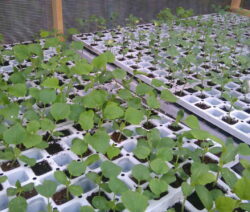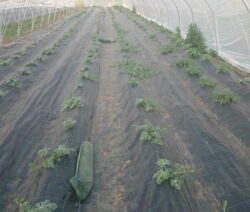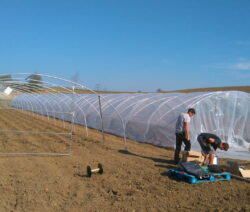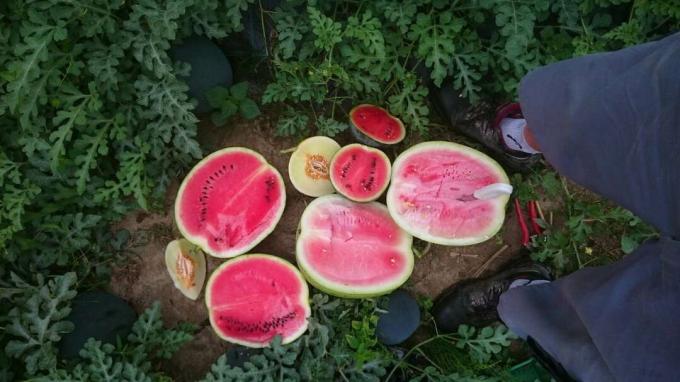An interview with Patrick Kirschner about growing melons, challenges in care and tips for hobby gardeners and melon fans.

Dear Mr. Kirschner, Melons from Dachau - that sounds a bit crazy at first. How did you come up with the idea of growing melons in the Dachau region?
We got the idea in March 2016. There we, Thomas and I, went to the Fürstenfeldbruck Agricultural School in Italy for a graduation trip. We looked at various farms there - including a large arable farm with around 950 hectares of melon growing area. That was, so to speak, the actual trigger and the initial spark for the idea of growing melons in our region.
What were the first reactions from those around you to this special idea?
During our graduation trip, Thomas and I thought about how an extension like this could work for us. Of course, our classmates noticed this, who tended to smile at us and didn't really take our idea seriously. The initial reactions from our friends and families were also similar. But as I said, those were only the first reactions. Family and friends have given us a lot of support right from the start, which has been a huge help for us and still is today.
How exactly does the cultivation work now? Don't melons like it very warm?
Warmth is of course important for the plants, especially at the beginning. We grow our plants in a heated growing station. It starts at the beginning of March. They stay there until May and only then do the seedlings come into our polytunnels. The tunnels are covered with a black mulch film, which has several advantages. On the one hand, it warms up the floor additionally, as a floor temperature of approx. 20C ° is optimal for the plant. It also protects against weeds and keeps moisture in the soil. Our tunnels are also equipped with drip irrigation. This type of irrigation reduces the risk of fusarium, as water only gets to the roots and not the plant.



That sounds like a very sophisticated system. Did you face difficulties too?
In the first year we planted the seedlings in the greenhouse too early. That turned out to be a mistake. Because at that time we had again received extreme frost and thus severe frost damage, as the plants are very sensitive. But we have learned from this and do not put the plants in the greenhouse until May, preferably after the ice saints. We also had problems with snails, as our young plants are very tasty for the animals. However, this problem solved itself with the late setting of the plants. The reason for this is that the plants then taste too "woody" for the snails and they then no longer eat them. That is of course good for us. Another lesson we learned was that growing the plants outdoors fails. The melon plants are very sensitive to fusarium and wet weather encourages fusarium infestation.
What types of melons do you grow in your fields?
A general distinction is made between watermelons and sugar melons. For watermelons, we have the Blacktail Mountian and Sugar Baby varieties (see. Early ripening watermelon varieties for Germany). These two types reach a weight of approx. 5 kg. In the field of sugar melons we have the Galia melon, honeydew melon and the cantaloupe.

And how long does it then take from seed to harvest?
This season, 2017, the seeds were on 7. March used and we were able to harvest from 15. July. That results in an average of around 130 days.
Is there anything about the cultivation that you would like to optimize even more for the next season?
The cultivation as it went this season was pretty good, but we still want to go next season try to start growing the plants as early as mid-February in order to harvest them as early as the beginning of July can. That could be difficult, however, as the plants need enough sunlight to thrive and that is very difficult in February. Let's see how it goes.
How intensive are your melons in the care? How do you fertilize and cut the watermelons?
Yes, we fertilize, but only once, with manure and before the plants are planted. Our melon plants do not receive any artificial fertilizers or pesticides from sowing to harvest. But this is only possible because we have the plants in the tunnels. Cutting the plants promotes fruit formation. But you can imagine that with over 1,000 plants, this is not exactly the nicest work.
When you have gone through the whole growing process and ready to harvest the ripe fruit, where are you delivering the fruit to?
The whole harvest goes to farm shops in and around Dachau. But we also have a farm shop in Friedberg and the Dasing farmers' market, where the melons are sold.



Are you planning to expand? Will the Dachau “Aromamelonen” be available in Munich soon, for example at the Viktualienmarkt?
As mentioned above, we not only have farm shops near Dachau that we supply, but also in the Aichach-Friedberg district. The reason for this is that I come from the municipality of Ried (b. Mering) and therefore we also supply in Aichach-Friedberg. In the next season we would like to supply even more farm shops in this district. What would also be interesting for us is REWE Regional. They have already asked, but we're not sure yet. Of course, the Viktualienmarkt would be a great option. So yes, if the opportunity existed, we would expand too.

What would you say makes your melons special, especially when compared to conventional supermarket goods?
It's very simple: our melons stay on the plant until they are optimally ripe. This allows the plant to store more sugar and vitamins in the fruit. This is not possible with melons from, for example, Italy, Spain and so on. There the melons are harvested before they ripen and only ripen during the freight route. If they were harvested ripe in Italy or Spain, they would arrive at the supermarket over-ripe. That means that since we don't have long freight routes, we can deliver sweeter or better tasting melons, which our customers confirm again and again.
Do you have a personal favorite?
Personally, I don't have a favorite and I think Thomas does too. Each variety has something for itself.
What kind of tips would you give hobby gardeners who want to try their hand at growing melons at home?
A greenhouse is best, but if it's not too cool and wet in the summer it can work outdoors. But you should make sure to plant the plant on the south side. And the planting site should be protected from the wind as much as possible. But it's best for amateur gardeners not to try it in the first place and just buy from us (laughs).
Last but not least: Do you have a tip or trick on how a layperson can tell when a melon is ripe?
With the watermelon you can tap the skin with your knuckle, this sound must sound a bit hollow and dark, then you know that the melon is ripe. The sugar melons are a little more difficult to interpret. Some types of melon can be recognized by their sweet smell. However, most of them need a lot of experience to find out whether a fruit is ripe.
Thank you for the interview.



